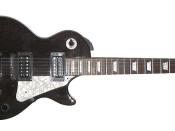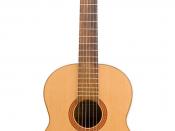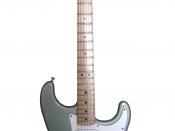The guitar has always played an essential role in music. From cavemen plucking strings on ancient acoustic guitars to Eric Clapton executing precise riffs at unimaginable speeds on his custom built Fender Stratocaster electric guitar, the guitar is diverse as well as consistent in its ability to adapt to any type of music. David Gilmore once said, "When you strum a guitar you have everything- rhythm, bass, lead, and melody ("Music Quote" Int.)." All of these elements are acquired by various kinds of guitars. There are many different types of guitars in existence.
The word acoustic is defined as "relating and influencing sound or sound waves (Acoustic 18)." The acoustic guitar relies on the natural acoustics within itself for sound (Hill 6-7). Historians and musicologists agree that the first acoustic guitar dates back to the ancient Assyrians, over 4,000 years ago. It was called a chetarah, a stringed instrument with a sound box.
Every culture in the world had a type of guitar. The Hebrews had a Kinnura, the Chaldeans had a Quitra, and the Greeks had a Citharas and Citharis. By the fifteenth century, the stringed instruments that had six strings were tuned from high to low. The pitches of the strings were G, C, F, A, D, and G. Today it is E, A, D, G, B, and E (Hill 15). During the late nineteenth century, Christian Fredrick Martin and Orville H. Gibson separately changed course of guitar history. Martin, already an experienced guitar maker, went to New York from Germany in 1833. In 1839 he and his family moved to Nazareth, Pennsylvania, and began again. It still operates there today. Martin developed the famous X- brace, from which all modern acoustic guitars are built with today (Sloan 8-9). Orville Gibson was born in Chateaugay, New York, in...


